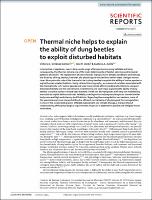| dc.creator | Giménez Gómez, Victoria Carolina | |
| dc.creator | Verdú Faraco, José Ramón | |
| dc.creator | Zurita, Gustavo Andrés | |
| dc.date.accessioned | 2023-08-23T01:58:21Z | |
| dc.date.available | 2023-08-23T01:58:21Z | |
| dc.date.issued | 2020-08-07 | |
| dc.identifier.citation | Giménez Gómez, V.C., Verdú, J.R., Zurita, G.A. (2020). Thermal niche helps to explain the ability of dung beetles to exploit disturbed habitats. Sci Rep; (10). | es_AR |
| dc.identifier.other | CCPI-FCF-A-085 | |
| dc.identifier.other | 24984 | |
| dc.identifier.uri | https://hdl.handle.net/20.500.12219/4992 | |
| dc.description | Fil: Giménez Gómez, Victoria Carolina. Consejo Nacional de Investigaciones Científicas y Técnicas. Instituto de Biología Subtropical (Puerto Iguazú, Misiones); Argentina. | es_AR |
| dc.description | Fil: Giménez Gómez, Victoria Carolina. Universidad Nacional de Misiones. Instituto de Biología Subtropical (Puerto Iguazú, Misiones); Argentina. | es_AR |
| dc.description | Fil: Verdú Faraco, José Ramón. Universidad de Alicante. Centro Iberoamericano de la Biodiversidad. Instituto Universitario de Investigación; España. | es_AR |
| dc.description | Fil: Zurita, Gustavo Andrés. Consejo Nacional de Investigaciones Científicas y Técnicas. Instituto de Biología Subtropical (Puerto Iguazú, Misiones); Argentina. | es_AR |
| dc.description | Fil: Zurita, Gustavo Andrés. Universidad Nacional de Misiones. Instituto de Biología Subtropical (Puerto Iguazú, Misiones); Argentina. | es_AR |
| dc.description | Fil: Zurita, Gustavo Andrés. Consejo Nacional de Investigaciones Científicas y Técnicas. Facultad de Ciencias Forestales (Eldorado, Misiones); Argentina. | es_AR |
| dc.description | Fil: Zurita, Gustavo Andrés. Universidad Nacional de Misiones. Facultad de Ciencias Forestales (Eldorado, Misiones); Argentina. | es_AR |
| dc.description.abstract | In terrestrial ecosystems, insects face a wide range of temperatures among habitats and time; consequently, the thermal niche is one of the main determinants of habitat selection and temporal patterns of activity. The replacement of native forests changes micro-climatic conditions and reduces the diversity of dung beetles; however, the physiological mechanisms behind these changes are not clear. We explore the role of the thermal niche in dung beetles to explain the ability of native species to exploit human-created habitats. Using infrared thermography, we measured variables associated with the thermal niche in 17 native species and used linear mixed-effects model and ANOVAs to compare disturbed habitats and the native forest. Endothermy and body mass explained the ability of dung beetles to exploit human-created open habitats. Small and diurnal species with very low endothermy were able to exploit deforested open habitats; evening/nocturnal/crepuscular species showed similar body mass and high endothermy in all habitats. Regarding thermoregulation mechanisms, none of the species (except one) showed defined or efficient mechanisms of physiological thermoregulation. In view of the accelerated process of forest replacement and climate change, a more profound understanding of the physiological requirements of species is essential to predict and mitigate future extinctions. | es_AR |
| dc.format | application/pdf | |
| dc.format.extent | 3.628 MB | |
| dc.language.iso | eng | es_AR |
| dc.publisher | Scientific Reports | es_AR |
| dc.relation | info:eu-repo/semantics/altIdentifier/urn/https://www.nature.com/articles/s41598-020-70284-8 | |
| dc.rights | info:eu-repo/semantics/openAccess | |
| dc.subject | Ecology | en |
| dc.subject | Physiology | en |
| dc.subject | Insects | en |
| dc.subject | Thermal niche | en |
| dc.subject | Native forests | en |
| dc.title | Thermal niche helps to explain the ability of dung beetles to exploit disturbed habitats | en |
| dc.type | info:eu-repo/semantics/article | |
| dc.type | info:ar-repo/semantics/artículo | |
| dc.type | info:eu-repo/semantics/publishedVersion | |



